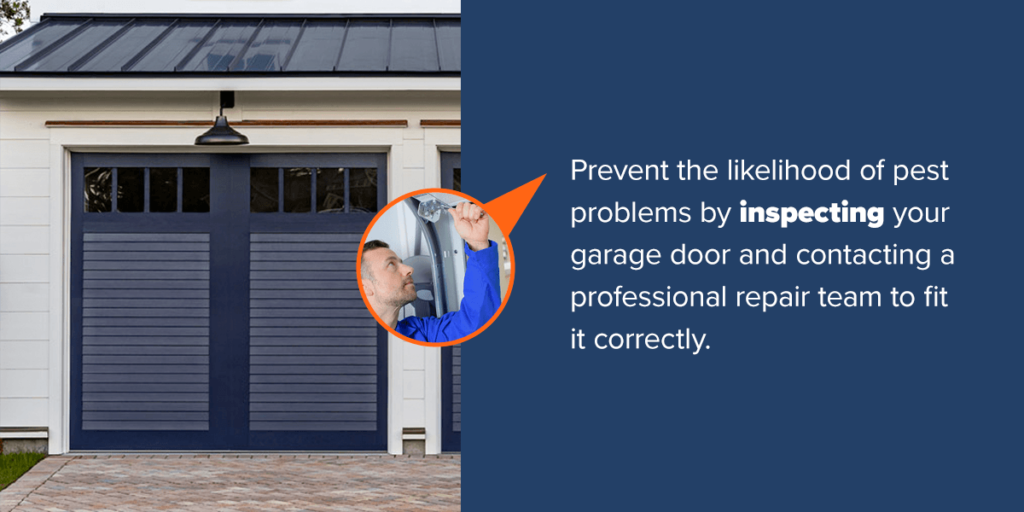Changes in the weather can prompt pests such as rodents, beetles and termites to seek out shelter, making your garage a prime location.
However, once pests set up a temporary home in your garage, they can weaken the physical structure and damage your possessions. In addition, some rodents and insects carry pathogens, which can impact your family’s health. Here’s what you need to know about maintaining a pest-free garage.
Common Types of Garage Pests
Knowing which pests are likely to enter your garage helps prevent infestation. Here are some of the most common insects and rodents to look out for:
Rats and Mice
Rodents like rats and mice often seek shelter in garages, causing damage to upholstered furniture, electrical wiring and any paper products in storage. They also present a severe risk to your health as they can transfer diseases in three ways:
- Rodent scratches or bites
- Carrying infected ticks, mites and fleas
- Contaminated water, food or dust from rodent droppings
Spiders
Spiders are another common pest in garages, as they seek out quiet areas where their webs can remain intact. Thankfully, only two of the 3,000 spiders found in the United States are venomous, yet their webs impact the overall appearance of your garage. Additionally, they can leave insect remains on the floor and other surfaces.
Termites
Termites may be one of the smallest pests to enter your garage, yet they can cause immense destruction. According to the Realty Times, termites affect roughly 600,000 homes in the United States annually. To control the situation and repair the damage, homeowners spend up to $5 billion annually.
Ants
Ants often enter your garage through small cracks, and as a colony insect, they arrive in vast numbers. While most ant species will cause minimal damage, carpenter ants are the exception and can harm your garage’s structural integrity.
As their name suggests, carpenter ants burrow through wood to create nests. This can weaken or damage any wooden objects in your garage, such as wooden work benches, shelving, or stored furniture.
Crickets
Crickets seek out warm, moist areas, so garages are particularly inviting during the cooler months. One of the most destructive species is the camel cricket, as they chew through fabric, making upholstered furniture and other material items vulnerable.
Beetles
Beetles look for warm places as winter approaches, so watch for these pests.
Carpet beetles are common intruders in American homes and garages. They build nests in fabric items, destroying curtains, clothing and other stored belongings. They can also lay approximately 100 eggs at a time, so removing these pests at the onset is best to prevent an infestation.
Flies
House flies thrive in temperatures of approximately 83 degrees Fahrenheit, making garages the perfect haven. Their ability to fly means they come into contact with countless surfaces, which spreads diseases. Humans risk contracting salmonellosis, typhoid, tuberculosis and other diseases from flies.
Sowbugs
Sowbugs require moist conditions to survive, which is why they will seek out damp areas in your garage. Their presence poses no real threat to your health or belongings, but keeping your garage pest-free is best.
Silverfish
Silverfish invade garages throughout the year but are widespread during winter. According to Healthline, silverfish consume cellulose, a substance found in paper products and dead skin cells such as dandruff. Books, old magazines, cardboard boxes and other paper products in your garage are prime targets for these pests.
In addition, studies have linked silverfish scales with allergen-based breathing problems, making them significantly more problematic.
Why Do Pests Like Garages?
After reviewing the different types of pests that frequent garages in the United States, you can see some common reasons why they venture indoors. These include:
- A need for protection: Creatures are hardwired to protect themselves, and garages offer protection against harsh weather conditions and predators.
- A need for warmth: Insects often need moist, warm areas to reproduce, so they search for these conditions to continue their life cycle.
- A need to eat: Bugs and rodents need food to survive and are attracted to the odors present in garages, such as the smell of stored food or trash.
7 Tips to Keep Pests out of the Garage
Here are our top tips for keeping your garage pest-free:
1. Remove Food Sources
Many homeowners store food in their garage, such as canned goods, pet food or a freezer full of frozen meals. While using your garage for storage is an excellent use of space, be mindful of any odors that could attract rodents and pests.
Keep pests out of your garage by using:
- Airtight containers to prevent pest contamination
- Overhead racks to ensure food stays dry and upright
- Fully functioning freezer equipment to prevent thawing
2. Clean Your Garage
Regular dusting can remove cobwebs and other debris which attracts pests. If you’re storing food in your garage, frequently sweeping and mopping your floors eliminates any food sources that entice rodents and bugs.
Aside from eliminating temptations for pests, cleaning your garage also alerts you to possible infestations so you can remove bugs from your garage.
3. Lay Traps
If you’ve tried to deter insects and rodents but still see them in your garage, consider laying traps. Bait traps are an effective solution for ants, while fly strips can assist in resolving a fly infestation.
The Humane Society International advises homeowners to select humane traps to capture and release mice and rats and check these at least three times daily.

4. Install Your Garage Door Correctly
When your garage door is flush against the frame, you can keep insects out of the garage as there is less chance of them crawling through small gaps.
Prevent the likelihood of pest problems by inspecting your garage door and contacting a professional repair team to fit it correctly.
5. Perform Regular Maintenance
Garages can withstand the elements, but general wear and tear occurs over time. Be proactive by examining your structure after extreme weather. If necessary, organize a maintenance team to repair the structure and seal it from pests.
6. Check for Cracks
Pests can invade your garage from your ceiling, walls, foundation and door, so periodically check these areas for cracks. If you notice places where pests could enter, seal these gaps.
7. Remove Cardboard Boxes
If you’ve been storing items in cardboard boxes, now is the time to declutter and upgrade your storage. Cardboard boxes are a food source for silverfish and a safe hiding place for other pests, so remove cardboard boxes to prevent infestations. Use sealed containers if you must store things in your garage.
Realize Your Goal of a Pest-Free Garage
Many pests can infiltrate garages, making garage door inspections and maintenance essential. If your door is misaligned or won’t close properly, contact our professional team for repairs and installations. With a service history spanning over 50 years, Marvin’s Garage Doors has the expertise to retain the structural integrity of your garage so you keep pests at bay.


